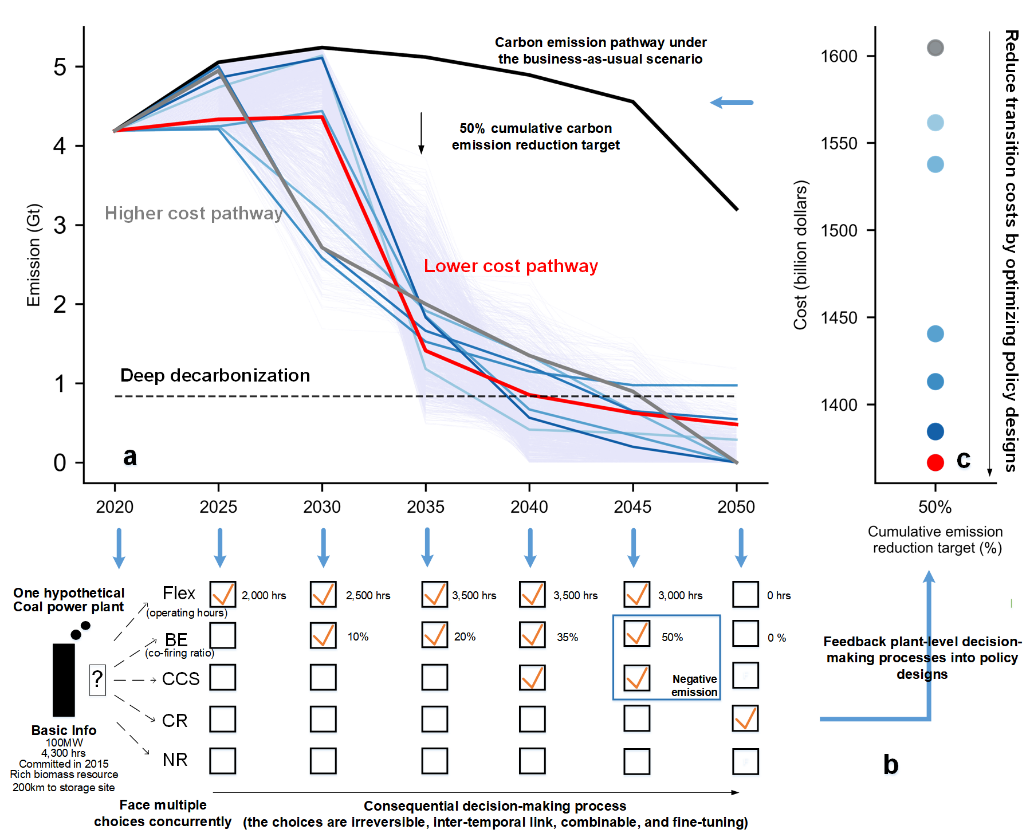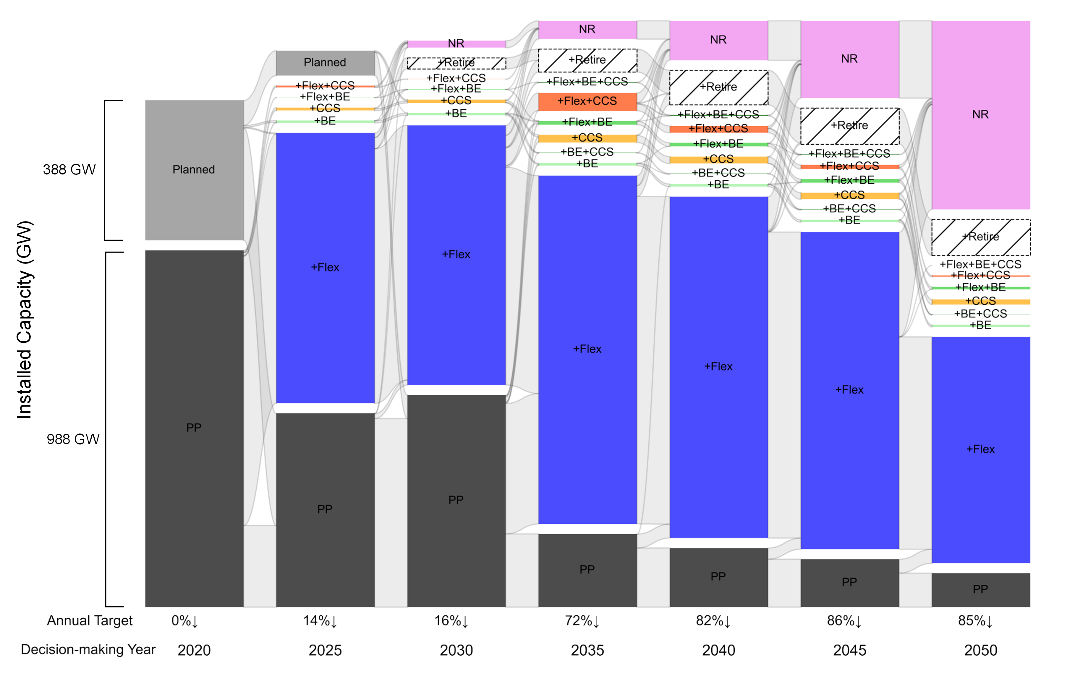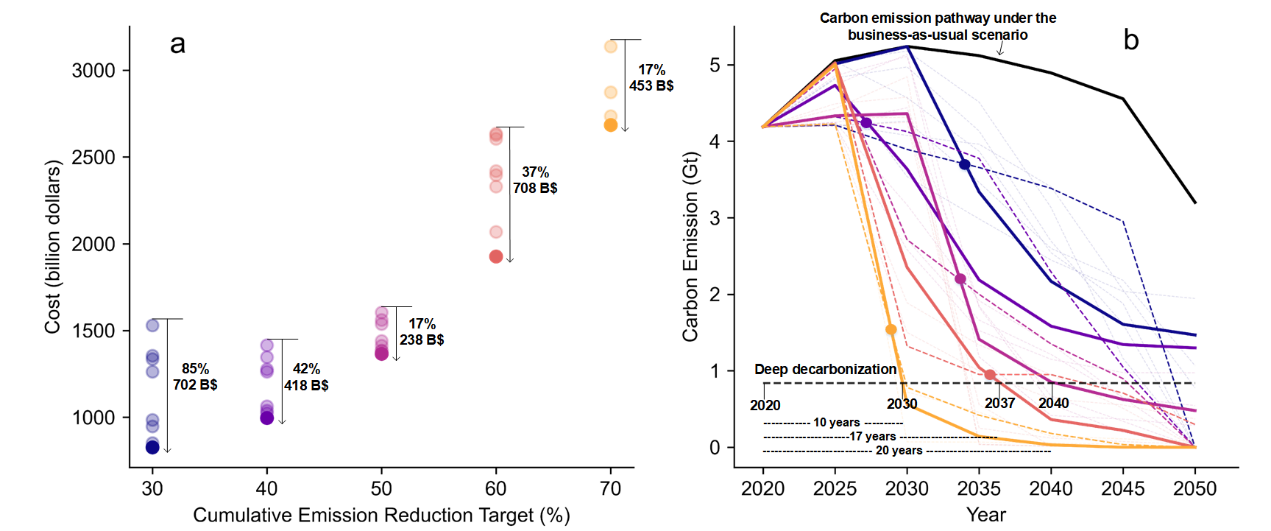Wenjia Cai’s group releases the innovative emission reduction strategies to facilitate a low-cost transition in the coal power sector
Tsinghua University News, February 3rd —Under the Paris Agreement’s 1.5°C target, global emissions from coal power plants need to decline rapidly. However, in developing countries like China and India, coal power capacity remains vast, with many plants newly built in recent years. Early retire these coal plants could result in substantial stranded assets. Besides compulsory retirement, coal power plants can reduce emissions through multiple strategies, such as biomass and coal co-firing, carbon capture and storage (CCS), and flexibility retrofits to reduce operating hours. Additionally, biomass co-firing combined with CCS offers the potential for negative emissions. Overly simplistic strategies, such as mandating plant closures without considering alternative pathways, risk increasing the costs of transitioning the coal power sector.
To address this issue, Professor Cai Wenjia's research group at Tsinghua University's Department of Earth System Science has developed a plant-level recursive dynamic optimization model (PLAnT-level dynamic Optimization model, PLATO). This model aims to explore the recursive dynamic transition pathways for coal-fired power plants under various emission reduction strategies. In this model, coal power plants can make decisions based on their installed capacity, operational start time, availability of local biomass resources, distance to carbon storage sites, and other characteristics. As national carbon reduction targets increase, the model will assist coal power plants in making sequential multi-phase decisions. Based on this model, the study constructed multiple carbon reduction scenarios that meet the same cumulative carbon reduction targets, investigating how different scenario curve shapes affect plant-level transition pathways and associated costs.
By applying the model to over 4,200 coal-fired power plants in China, the study found that without taking any emission reduction strategies, currently operating and soon-to-be-commissioned plants would lock in 160 billion tons of carbon emissions from 2020 to 2050. If a 50% cumulative emission reduction target is set, the most cost-effective reduction pathway would involve reaching a relatively low emissions peak by 2030 and maintaining low emission levels through 2050 (Figure 1).
Applying the model to over 4,200 coal power plants in China, the study found that under the business-as-usual scenario, currently operating and planned-to-be-commissioned plants would lock in 160 billion tons of carbon emissions ahead of schedule. If a 50% cumulative emission reduction target is set, the most cost-effective reduction pathway would involve reaching a relatively low emissions peak by 2030 and maintaining low emission levels through 2050 (Figure 1).

Figure 1. Plant-level dynamic decision-making process under carbon reduction pathways
Under this carbon reduction scenario, approximately 88.3%, 6.2%, and 2% of coal power plants will adopt flexibility retrofits, carbon capture and storage, and biomass co-firing strategies during their dynamic transition pathways, while only 7.3% of coal power capacity will be retired early. The total transition cost for this scenario is approximately $1.37 trillion, with higher transition costs in regions like Xinjiang, Shandong, and Inner Mongolia due to factors such as total installed capacity, the number of power plants, and the remaining lifespan.

Figure 2. Evolution of emission reduction technology structure under the low-cost scenario with a 50% cumulative emission reduction target
The study found that under China's "dual carbon" goals, neither the timing of peak emissions in the coal power sector nor achieving net-zero emissions by 2050 is the key to reducing transition costs for coal power plants. Instead, accelerating emission reduction efforts between 2030 and 2040 to achieve deep decarbonization plays a crucial role in lowering transition costs for China's coal-fired power plants. Moreover, carefully designed carbon emission reduction scenarios enable higher cumulative emissions reductions without incurring additional costs.

Figure 3. Lower-cost carbon transition scenarios under various cumulative carbon reduction targets (Figure a shows the transition costs of different carbon emission reduction scenarios under various cumulative reduction targets. Figure b shows the curve shapes of carbon emission reduction scenarios under different cumulative reduction targets; solid lines represent low-cost scenarios, dashed lines represent high-cost scenarios; curve colors correspond to Figure a; deep decarbonization refers to an 80% reduction in CO2 emissions compared to 2020 levels).
The related research findings, titled "Reducing transition costs towards carbon neutrality of China's coal power plants," were published online in Nature Communications on January 2nd. Tsinghua University’s Ph.D. student Wang Rui (2020 cohort) is the first author. Professor Cai Wenjia from Tsinghua University is the corresponding author. Co-authors include Associate Professor Cui Yiyun (University of Maryland); researchers Huang Lin, Ma Weidong, Zhang Jia, and Bian Jiang (Microsoft Research Asia); Dr. Qi Binbin (China University of Petroleum-Beijing); postdoctoral researcher Li Haoran, Zhang Shihui, Ph.D. student Shen Jianxiang (Tsinghua University); researcher Zhang Xian (Administrative Center for China’s Agenda 21); Professor Zhang Jiutian (Beijing Normal University); Associate Professors Yu Le, Li Wei, Zhang Ning, and Professor Wang Can (Tsinghua University). The research was supported by the National Natural Science Foundation of China, the Tsinghua-Rio Tinto Joint Research Center for Resources, and Microsoft Research Asia's collaborative research projects.